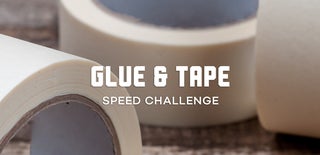Introduction: Simple Homemade Miter Saw Clamp - From Existing F Type Clamp | DIY
If you have a miter saw, you may got it without a clamp, used for holding the material you cut (Or maybe your clamp just got lost...)
I got this great old Makita sliding miter saw lately, and it was without it's original vertical clamp.
I checked on the net, and saw that such original clamp price is around 40 USD. So, I decided to try making one myself, using materials that I had at home.
As you can see in the video, I used an existing simple F type adjustable clamp (which costed ~4 USD), and some scraps of wood.
It took me about 30 minutes to make this project.
You're welcome to visit my YouTube Channel, subscribe, and also watch my additional projects. Don't forget to click the 'bell' button in order to get new videos notification.
Thank you!
Supplies
Materials:
- F type vertical adjustable clamp
- Some small pieces of scrap wood
- Strong glue (for metal + wood)
General List of tools I'm using - https://www.itzikdiy.com/tools-list?m=1
Tools in this Instructable:
- Miter saw
- Measuring tape
- Dremel or angle grinder, with metal cutting discs
- Safety glasses
- Another clamp
- Knife
- Drill driver
- 19mm drill bit
- Sanding paper
- Caliper measuring tool
Step 1: The Original Clamp
This is the original F type clamp I used.
You need a clamp that after cutting it, it would be smaller than the intended clamp hole, in your miter saw.
Step 2: Measuring the Height of the Clamp
I marked the cutting position - so the new clamp length will be about 10cm long.
Step 3: The Tool for Cutting the Clamp
I took Dremel 4000 with a metal cutting disc. You can use angle grinder as well.
Step 4: Cutting the Clamp
I cut the clamp in the marked position.
Step 5: Checking the Clamp Position
I inserted the clamp to the intended hole in the saw, to check that it fits.
Step 6: Preparing the Clamp Wooden Base - 1
Since that the clamp doesn't have rounded rod, I needed to make it rounded, so it would fit the intended hole in the miter saw.
I took a piece of square wood profile and carved it with a knife, so it would be round and fit the hole tightly.
(If you have a rounded wood profile that fits, you can skip this step).
Step 7: Preparing the Clamp Wooden Base - 2
I took the rounded wood profile, and cut it along, with the miter saw, and later cut the 2 splitted pieces.
Step 8: The Clamp Wooden Base Is Ready
I took the 2 wooden rounded pieces and put over the clamp rod to check that it fits.
Step 9: Gluing the Clamp Wooden Base - 1
I put a very strong glue over the 2 sides of the clamp metal rod.
This glue is good for wood and metal as well.
Step 10: Gluing the Clamp Wooden Base - 2
I put the 2 wooden rounded pieces over the clamp rod with the glue.
Then I put it to dry, holded by another clamp :)
Step 11: Sanding the Clamp Wooden Base
After full dry, I sanded the new wood base a bit, with a sanding paper.
Step 12: Making the Clamp Wooden Press Base
Basically, the clamp is ready.
Since that the clamp press plastic cover was lost, I decided to prepare a wooded press base.
I measured the diameter of the clamp metal press, using a caliper measuring tool, and it was ~19mm.
I took 19mm drill bit and drilled a rounded socket in a piece of wood board.
Later, I cut around the socket, with the miter saw to have a small rectangle piece with a socket.
Step 13: Gluing the Clamp Wooden Press
I put the new miter saw clamp in the intended hole in the saw base.
I took the wooden press base with the rounded socket I made, put the same glue that I used before, inside the socket, and tightened the clamp metal over it.
Step 14: The Result
The miter saw clamp is ready!
Step 15: Testing the Clamp
I put the final miter saw clamp in the intended hole in the saw base and started to use it for different cuts.
Step 16: Clamp Usage 1
I started with cutting long 7*7cm wooden profile, and holded it with the clamp.
It holded it very well.
Step 17: Clamp Usage 2
Another usage, of holding wood piece which is far from the fence. For example, in half lap joint cuts, when the wood shouldn't be close to the fence, so the cut will be straight and not rounded due to the saw blade.
In this case, I put another small piece on top of both long pieces, so it would press them both.
Step 18: Clamp Usage 3
Last usage, is for cutting small pieces of wood.
I put a jacking piece of wood, on the left, higher than the piece I'm going to cut.
Then I put another piece of wood diagonally, over both the left piece and the right small piece, so it would press it tightly with the clamp. Finally, I cut the piece.
Note: In the video I'm showing cutting of smaller pieces than in this example.
These pieces are smaller than the saw's fence middle spacing.
After some people watched my video - I was warned that this can be very dangerous, since that although the clamp presses the small piece, due to the speed of the saw blade, cutting without the fence support can cause the small pieces can fly like a rocket.
Step 19: The Video
That's it, you can watch the video to see the full process and some uses of the clamp.
You're welcome to visit my YouTube Channel, subscribe, and also watch my additional projects. Don't forget to click the 'bell' button in order to get new videos notification.
Thank you!

Participated in the
Glue & Tape Speed Challenge













